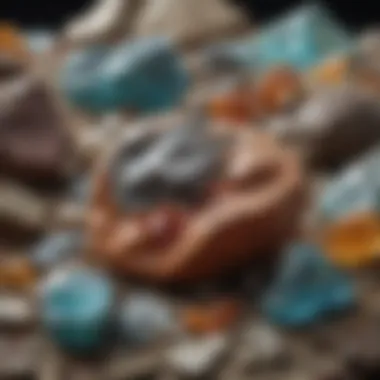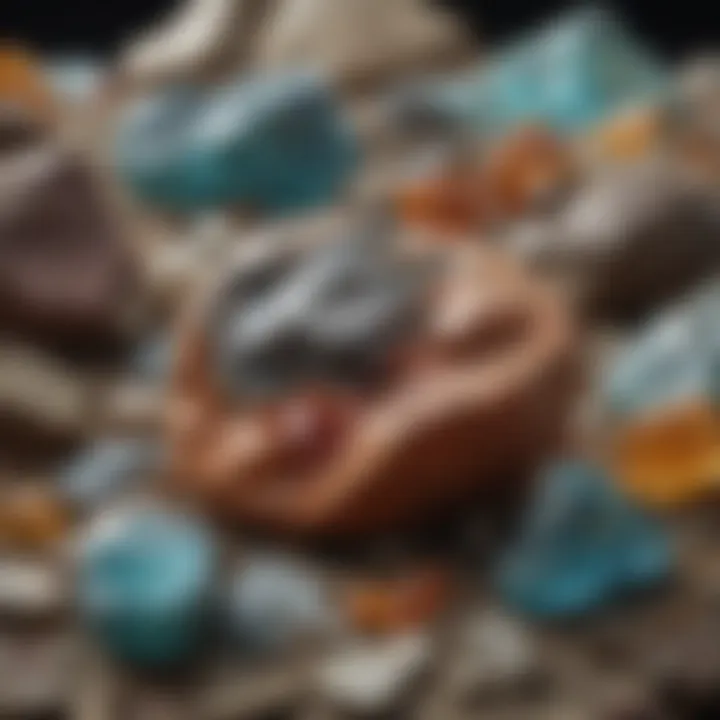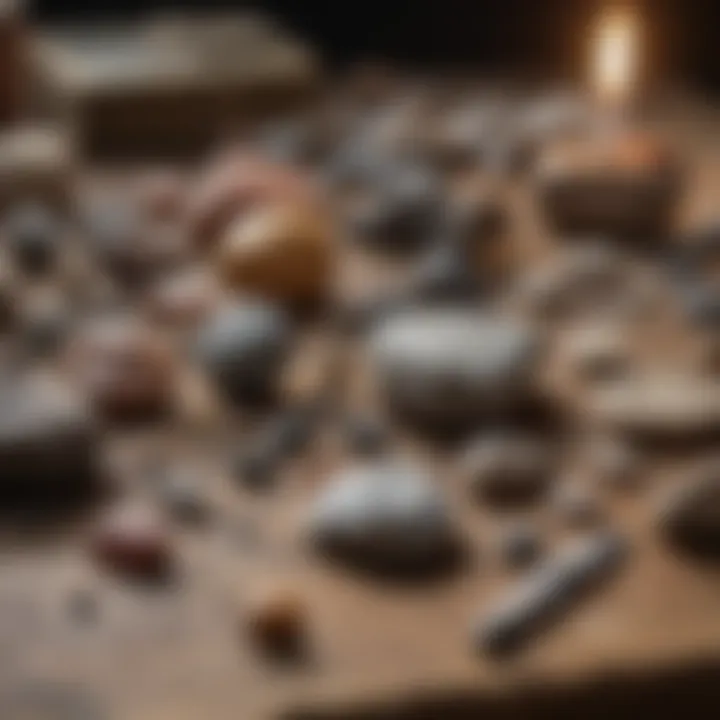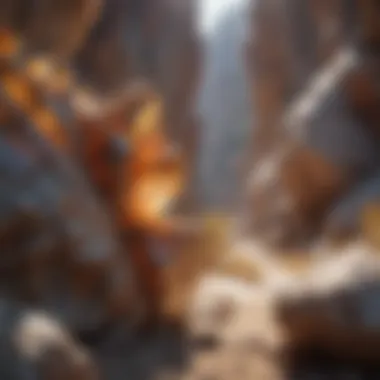Mastering Rock and Mineral Identification Techniques


Intro
Understanding rocks and minerals is not just about collecting pretty stones; it’s about uncovering the stories that our Earth has to tell. This journey into geology opens windows to ancient environments, shifts in tectonic activities, and even the climatic conditions of bygone eras. Indeed, each rock and mineral specimen is like a time capsule, offering collectors an intimate glimpse into the natural world. Through this guide, we will delve into the methods of identification, the significance of these natural artifacts, and the cultural narratives that intertwine with our pursuit of knowledge.
History and Origins
Overview of Collectibles, Rocks, and Fossils
Throughout history, humans have been enamored with the natural world around them. From the primal days of hominins selecting rocks for tools to today’s enthusiasts scouring riverbeds for stunning agates, the attraction to rocks and minerals is age-old. Collections may vary from simple pebbles found on a family hike to meticulously curated displays showcasing rare minerals, each piece telling a tale of its own. In many cultures, certain rocks have held significant spiritual or artistic value, shaping traditions and rituals through the ages.
Historical Significance and Cultural Impact
The significance of rocks and minerals extends beyond mere aesthetics; it has reverberated through cultures worldwide. For instance, jade has been revered in Chinese history, embodying virtues such as purity and beauty. Native American tribes often ascribed spiritual significance to specific stones, using them in rituals and ceremonies. The famous Stonehenge, formed from bluestone, raises questions of ancient religious practices, showcasing how rocks have both literally and metaphorically shaped past human experiences.
"Rocks are time travelers of our planet, thawing the frozen narratives of Earth's history."
Identification and Classification
Guide to Identifying Rocks and Fossils
Identifying rocks and fossils relies largely on observation and practical techniques. It's not merely about spotting something shiny or interesting; it requires an analytical mindset and an understanding of key characteristics.
- Color and Luster: The first observations can be quite telling. Notice how a mineral sparkles in the light, whether it’s dull, metallic, or glassy.
- Streak Test: Rubbing the specimen against an unglazed porcelain tile can reveal its true color in powdered form, helping to distinguish between similar-looking minerals.
- Hardness: Knowing how to use the Mohs scale, where talc is the softest and diamond is the hardest, aids collectors in assessing the durability of their finds.
- Cleavage and Fracture: Observing how a mineral breaks can be a key identifier. Some minerals split along neatly defined lines, while others shatter unpredictably.
- Additional Properties: Conducting simple tests such as for magnetism or effervescence (when exposing minerals to acid) provides additional clues about their identity.
Common Types and Variations
The world of rocks and minerals is vast, yet some types are frequently encountered by collectors. Here’s a brief overview:
- Igneous Rocks: Formed from cooled magma, examples include granite and basalt.
- Sedimentary Rocks: Created by the deposition of materials, think limestone or sandstone.
- Metamorphic Rocks: Resulting from high pressure and temperature, you might encounter marble or schist.
In the realm of minerals, some common types include quartz, feldspar, and calcite. Each variation brings its unique attributes and combinations of forms, colors, and uses, offering endless opportunities for exploration.
In concluding this section, it’s evident that our relationship with rocks and minerals is deeply rooted in history and culture. They offer a tangible link to our planet's past while also engaging our curiosity for the future.
Understanding Rocks and Minerals
Understanding rocks and minerals forms the backbone of geological sciences and is crucial for anyone delving into rock and fossil collection. These natural materials are not just visually captivating; they hold the keys to Earth's history, evolution, and the processes that shape our planet. By comprehending their characteristics, properties, and origins, collectors can hone their skills in identification and appreciation.
It's imperative to recognize that rocks and minerals both differ fundamentally and complementarily. Rocks are aggregates of minerals, while minerals are pure substances made up of specific chemical compositions. This distinction allows collectors to categorize their finds, understand their formation, and map out their geological importance. A solid grasp of these definitions not only enhances identification techniques but also fosters deeper connections with the specimens in one's collection.
Moreover, knowing how rocks and minerals fit into the larger context of the Earth’s processes can significantly elevate a collector's experience. For example, understanding the rock cycle—the perpetual transformation of rock types—gives insights into why certain rocks are found in specific locations and under what conditions they were formed. This understanding can ultimately lead to better collecting practices and more informed appreciation for the natural world.
"By understanding rocks and minerals, collectors unlock layers of Earth's history waiting to be discovered in their own backyards."
In exploring the definitions of rocks and minerals, along with their intriguing characteristics, collectors can also engage in discussions about their ethical collection methods, contributing to the conservation of these precious resources. Assessing how to collect responsibly while deepening one's knowledge leads to a richer hobby or vocation.
To summarize, knowing the differences, the rock cycle, and the importance of proper identification arms collectors with the knowledge necessary to develop their eye for detail, making their endeavors not only fulfilling but also significant in a broader environmental context. This leads us into the essential definitions of rocks and minerals.
Key Characteristics for Identification
Understanding the key characteristics of rocks and minerals is paramount for anyone looking to delve into the world of geological identification. These characteristics act as a roadmap, guiding collectors and enthusiasts through the intricate landscape of natural specimens. Recognizing and mastering these traits not only empowers individuals to distinguish between various rocks and minerals but also enhances their overall appreciation for the Earth's diverse geological makeup.
Color
Color serves as one of the most noticeable features in rock and mineral identification. It can provide initial clues about a specimen's identity; however, it must be approached with caution. For instance, minerals like quartz can display a range of colors depending on impurities. A bright pink tourmaline, while captivating, might lead one astray if judged solely on color. Thus, understanding that color can be an unreliable indicator is essential. Always consider other traits in conjunction with color to form a more accurate identification.
Luster
Luster refers to how a mineral reflects light, playing a significant role in the identification process. It can be categorized into several types, including metallic, glassy, pearly, and dull, to name a few. For example, galena has a pronounced metallic luster, while talc showcases a more greasy or waxy feel. Understanding luster can provide critical insight into the mineral class—metals showing a metallic luster often belong to distinct groups like sulfides or native elements. Observing luster under different lighting conditions can also yield different results, making it wise to experiment when identifying minerals.
Hardness
The hardness of a mineral is a tangible measure of its resistance to scratching, often referred to through Mohs Hardness Scale, which ranges from 1 (talc) to 10 (diamond). This measurement is a cornerstone for identification since it can help determine a mineral's place in the geological hierarchy. For instance, if a specimen scratches glass (average hardness of 5.5) and easy to scratch with a fingernail (about 2.5), you are likely looking at a mineral like fluorite or apatite. Remember, this test isn't just for rocks; it applies to crystals and minerals alike.
Cleavage and Fracture


When examining a specimen, understanding how it breaks is crucial. Cleavage refers to the tendency of a mineral to break along specific planes, whereas fracture indicates a more random breakage pattern. For example, mica displays perfect cleavage, easily peeling into thin sheets that reveal its unique layering. In contrast, quartz displays conchoidal fracture, breaking with smooth, curved surfaces resembling the pattern of a clam shell. Observing these traits can not only aid in identification but can also offer insight into the mineral's internal structure and bonding.
Streak Test
The streak test involves rubbing a mineral across a porcelain plate to assess the color of its powder. This test often provides a clearer picture of a mineral's true color than the surface color, as some minerals may show dramatically different colors when powdered. For example, hematite dust appears reddish-brown, while its solid form might appear metallic gray. This characteristic can help differentiate between minerals that may seem similar when viewed in bulk but varying significantly in powdered form.
"Relying on a single characteristic for identification might lead to a misunderstanding. Combining traits increases accuracy and strengthens confidence in your deductions."
In summary, each of these characteristics—color, luster, hardness, cleave and fracture, and streak test—works together in a symphony, offering insights into the fascinating world of rocks and minerals. Mastery of these elements gives one an edge, allowing for more accurate and insightful identifications.
Types of Rocks
Understanding the various types of rocks is foundational in the field of geology and serves to inform rock and mineral identification. Each rock type—igneous, sedimentary, and metamorphic—uncovers a distinct story of formation, composition, and environmental conditions. For collectors, knowing these types provides insight into the origins of their specimens, enriching their appreciation and context.
Igneous Rocks
Classification
Classification of igneous rocks centers primarily around their origin and the mineral composition present. They are generally divided into two main categories: intrusive and extrusive. Intrusive rocks, like granite, form from magma that cools slowly beneath the Earth's surface, leading to large crystal sizes. Extrusive rocks, such as basalt, cool quickly on the surface, resulting in smaller, fine-grained crystals. This distinction is a gem for any rock enthusiast, offering a straightforward avenue to identify an igneous sample based on where it formed—either inside or outside the volcano.
A unique characteristic of classification is its role in guiding collectors. Knowing that specific colors, textures, or crystal sizes align with either intrusive or extrusive types directly correlates to identification. Yet, while this classification aids in understanding, some may find it limiting, as many igneous rocks may exhibit characteristics straddling these classifications.
Examples
When considering examples of igneous rocks, granite and basalt stand out prominently. Granite, with its light color and coarse texture, is a popular choice among collectors wanting to showcase brilliant crystal formations, making it ideally suited for decorative purposes. On the flip side, basalt, recognized for its dark hue and smooth finish, serves as a key example of raw volcanic activity's aftermath.
These examples elucidate how different conditions lead to varied rock types. The charm of granite lies in its diversity of colors, often flecked with quartz, while basalt’s even texture underscores its rapid cooling. Nevertheless, collectors should be mindful as well; while both rocks are visually appealing, they can be quite heavy, presenting a challenge for some.
Identification Tips
Identifying igneous rocks can be an exhilarating journey through texture and hardness. First and foremost, one could examine the texture to determine whether it's coarse or fine-grained. This can instantly hint towards its classification. Secondly, using a hardness scale like Mohs can be useful—as many igneous rocks, particularly granite, score high on the scale.
Another practical tip might involve observing the mineral composition; if one spots quartz, feldspar, or mica, it points toward igneous origins, particularly granite. The caveat, however, lies in the labor-intensive process of checking for rare minerals—although rewarding, it may not fit every novice collector's resources or interests.
Sedimentary Rocks
Formation Processes
The formation processes of sedimentary rocks are equally engaging as they unravel the nature of erosion, deposition, and lithification. These rocks typically develop in layers over time, where sediments are compacted and cemented together. This layered structure not only serves as a visual hallmark of sedimentary rocks but also sheds light on the environmental history of an area.
For collectors, understanding this process enriches the narrative behind each specimen. When holding a sandstone fragment, one isn't merely grasping a rock; they are holding fragments of ancient landscapes where wind and water once shaped the Earth. The downside? Collectors need patience, as sedimentary rocks often form over vast timescales, adding complexity to their collection journeys.
Common Types
Among common types of sedimentary rocks, sandstone, limestone, and shale are noteworthy. Sandstone often showcases vibrant colors and fine grains, making it captivating for collectors. Limestone, on the other hand, frequently hosts fossilized remains, proving an extra allure for those interested in paleontology. Shale, while less visually striking, can reveal a wealth of information regarding historical geology based on its layered composition.
Identifying these types provides insights into both the rock's formation environment and its potential future. Although sandstone can often be mistaken for igneous materials due to similar textures, its layering typically sets it apart once examined closely.
Identification Techniques
When it comes to sedimentary rocks, identification techniques often revolve around examining layers and material composition. A fundamental approach includes inspecting for fossils, which can be a telltale sign of certain sediment types like limestone. Another method involves touch; if a rock feels gritty or sandy, it might just be sandstone.
While these techniques serve well, some may find that sedimentary rocks lack the immediate visual drama found in other types, potentially downplaying their intrigue. This isn't to say that they don't hold significant historical value; understanding the layers tells a story spanning millions of years.
Metamorphic Rocks
Transformation Process
The transformation process of metamorphic rocks is where the magic happens in geology. It involves the alteration of existing rock types subject to heat, pressure, or chemically active fluids, creating entirely new mineral structures. This metamorphic process can take eons, leading to features that tell their own geological odyssey—which is a captivating aspect for any collector.
This transformation not only represents a phase of change but also signifies stability over time. Such rocks offer a glimpse into the Earth's dynamic crust and are often indicative of specific geological conditions. However, identifying this type may present challenges, particularly for those unfamiliar with the nuances of mineral changes.
Key Examples
Prominent examples of metamorphic rocks include marble and schist. Marble, formed from limestone, is prized for its beauty and often used in sculpture and architecture, showcasing a striking appearance that many collectors seek. Conversely, schist, known for its shiny mica flakes, is valuable for educational purposes, demonstrating the effects of high-grade metamorphism.
While each example displays unique beauty and structure, they also remind collectors that beauty can stem from great pressure, both literally and figuratively.


How to Identify
Identifying metamorphic rocks involves looking for specific textures and mineral alignments. A rock like marble typically appears smooth and often showcases swirling patterns, hinting at its limestone origins. Schist, with its prominent layers and shiny appearance, can be easily identified through its characteristic foliation.
Using a hand lens can facilitate this process, revealing grain details and helping to distinguish between similar rocks. Identifying these intricate differences enriches the experience, yet some may find themselves wrestling with the broader spectrum of changes that metamorphic rocks undergo, making them somewhat of a Rubik's cube in the rock world.
"In the realm of rocks, each type holds a story, waiting to be deciphered by those willing to observe carefully."
Common Types of Minerals
Understanding common types of minerals is vital for any rock and mineral enthusiast. Not only do these minerals shape our natural world, but they also influence various industries, from technology to construction. The right knowledge can enhance a collector's ability to identify, appreciate, and understand the significance of these materials. Each type of mineral possesses unique characteristics and chemistry that dictate how they form, where they can be found, and how they can be utilized.
Silicates
Silicates are the most abundant group of minerals, constituting about 90% of Earth’s crust. They are primarily composed of silicon and oxygen, forming the basic building block known as the silica tetrahedron. This tetrahedron shapes how silicates are organized, leading to various structural forms.
The importance of silicates lies in their widespread presence and diversity. You’ll come across feldspar, quartz, and mica frequently. If you’re an avid collector, you may find quartz in its many forms like amethyst or citrine. Knowing how to distinguish between different types of silicates can help in your identification quests.
"Every rock tells a story, and silicates often hold the narrative of the Earth itself."
Carbonates
Carbonates are another significant group characterized by the presence of the carbonate ion (CO₃) in their structure. Calcite and dolomite are prominent examples. Understanding carbonates is essential, especially in areas where limestone formation is common. They typically form in sedimentary environments and can often be identified by a distinct reaction with weak acids, which is a handy trick for hobbyists in the field.
While beautiful, collecting carbonate minerals can pose challenges. Their solubility in acid means they may not preserve well unless cared for properly. Recognizing their importance in geology, especially concerning sedimentary processes, can enhance your collecting experience.
Oxides
Oxides consist of elements combined with oxygen. This category includes minerals such as hematite and magnetite. These minerals not only contribute to the composition of rocks but also play crucial roles in various industries, including the production of iron and aluminum.
Detecting oxides often requires a keen eye. For instance, hematite stands out with its metallic sheen and reddish hue. Collectors should pay attention to the color and luster to identify specific oxide minerals. The unique properties of oxides can sometimes make them prized specimens in your collection.
Sulfides
Sulfides are distinguished by the presence of sulfur along with a metal. Common examples include pyrite and galena. These minerals often present a striking appearance and can be easily recognized based on their metallic luster. They also play an essential role in the geological formation processes, such as the formation of ore deposits.
When collecting sulfides, you'll notice they can vary significantly in quality and could be worth significant value. Additionally, learning how to distinguish between similar-looking sulfides is critical. Each will have its own characteristics based on composition and environmental conditions.
Phosphates
Phosphates contain crucial elements such as phosphorus and are fundamental in various biological processes. Common minerals include apatite, which can be found in many igneous and metamorphic rocks. Phosphates are essential for plant growth, making them particularly interesting for collectors who are also keen on biology.
In the field, phosphates can resemble carbonates and might even be mixed in certain geological settings. Understanding their properties will aid in correct identification. Notably, they tend to be less common than the other groups but are equally fascinating in their development and uses.
In summary, becoming well-versed in these common types of minerals allows collectors to appreciate the deeper connections between mineralogy, geology, and their significance in our daily lives. Each mineral group offers a chance to explore new educational avenues, fostering a more profound understanding of the world beneath our feet.
Practical Identification Techniques
Practical identification techniques are at the heart of successfully recognizing and categorizing rocks and minerals. These methods empower hobbyists and experts alike, enabling them to explore the earth’s treasures with confidence. The beauty of practical techniques lies in their accessibility; nearly anyone can begin to identify the geological wonders at their feet with the right tools and knowledge.
One important consideration when employing these techniques is the variety of tools and resources available. From small hand lenses to contemporary apps, these identification aids can enhance accuracy and understanding. Here’s a closer look at some of the primary methods used in rock and mineral identification that promise insight and clarity to the collector's journey.
Using a Hand Lens
A hand lens, often referred to as a jeweler’s loupe, is an essential tool in the identification toolbox. This simple yet effective magnifying device helps you assess the texture, colors, and structural elements of a specimen more clearly. What makes the hand lens special is its ability to reveal details otherwise invisible to the naked eye.
When looking through a hand lens, you can often observe crystal formation and composition that points towards specific mineral types. This is particularly beneficial for differentiating between similar-looking minerals, ensuring a more precise identification. Common hand lenses come with magnifications of 10x or 20x, which is often sufficient for most casual collectors. However, one must be cautious about the limitations of this tool; under higher magnification, some materials may appear distorted, which could mislead identification efforts.
Conducting Field Tests
Field tests are practical, hands-on ways to gain insights into a rock or mineral's identity. These tests rely on observable and measurable properties, making them both intuitive and reliable. Two such tests often employed by collectors are the Acid Test and the Magnetism Test.
Acid Test
The Acid Test is a straightforward method, primarily utilized to identify carbonate minerals, such as calcite or dolomite. By placing a drop of dilute hydrochloric acid on the mineral, you can observe whether it fizzes or reacts, which would indicate calcium carbonate presence. The fizzing occurs due to the release of carbon dioxide gas when the acid reacts with the mineral. This reaction not only helps confirm identification but also serves as a quick field expedient.
One unique feature of this test is that it’s readily accessible. Collectors can carry a small bottle of diluted acid, making it easy to perform on-site. However, safety is paramount; protective goggles and gloves are recommended when conducting this test to avoid any accidents with the acid. Moreover, its efficiency is somewhat limited since it only effectively identifies certain minerals and may not conclusively determine the specific type.


Magnetism Test
The Magnetism Test focuses on identifying minerals that exhibit magnetic properties. This test can be conducted with a small magnet; by bringing it close to the specimen, you can determine whether it shows any attraction. This test is particularly useful for identifying iron-rich minerals such as magnetite.
The key characteristic of the Magnetism Test is its simplicity and directness. It offers a quick and non-destructive means of assessment, making it popular among mineral enthusiasts. However, there’s a unique drawback—it won't help identify non-magnetic minerals, which diminishes its overall scope.
Utilizing Reference Books
Reference books remain a foundational resource for anyone serious about rock and mineral identification. These books have illustrations, descriptions, and key characteristics of thousands of minerals and rocks. By consulting these, collectors can cross-reference their findings. It offers an excellent way to not just confirm potential identifications but also expand on knowledge.
Online Tools and Apps
In today’s digital age, a plethora of online tools and apps provide additional avenues for identification. Many applications come equipped with image databases and identification guides at your fingertips. These resources complement traditional techniques, enabling collectors to enhance their identification knowledge.
Using a combination of both analog and digital methods allows for a richer and more informed identification process. Whether you are identifying a shimmering quartz crystal or the solid build of a granite specimen, leveraging practical techniques will deepen your connection with each find.
The Importance of Proper Identification
Identifying rocks and minerals is not just an idle endeavor; it holds significant importance for collectors, educators, geologists, and nature enthusiasts alike. Understanding the nuances of proper identification is foundational for a variety of reasons, particularly in fostering a deeper appreciation for the earth's treasures. Here are some key elements that underline its importance:
Educational Value
The process of identifying rocks and minerals is inherently educational. Collectors learn to observe, analyze, and categorize specimens based on distinct characteristics such as color, texture, and hardness. This analytical method not only enhances one’s knowledge about geological materials but also sharpens critical thinking skills. For instance, while observing a quartz crystal, a collector might notice its hexagonal shape and clarity. They are not merely identifying a specimen; they are engaging with the very principles of crystallography and geology. This aspect of learning ignites curiosity and encourages a lifelong pursuit of knowledge in the field of earth sciences.
Collecting Ethics
A significant consideration in rock and mineral identification is understanding the ethics surrounding collection. Ethical collecting practices are rooted in the responsibility of collectors to respect nature and the environments from which they source their specimens. Proper identification ensures that individuals recognize the legal and ethical implications of their actions. For example, many sites harbor rare or endangered minerals. Recognizing the value and rarity of these resources compels collectors to refrain from harvesting them irresponsibly. This ethical approach fosters a culture of respect and sustainability within the community.
Conservation Concerns
Conservation goes hand in hand with proper identification. As collectors become enlightened about specific minerals and their habitats, they develop an appreciation for the ecological significance of these materials. Many geological sites are under threat from development and environmental degradation. By intimately understanding the various specimens and their contributions to the ecosystem, collectors can advocate for conservation efforts. Being informed leads to a vigilant community that can act as stewards of the natural world, ensuring both preservation of sites and compliance with regulations.
Enhancing Collection Value
Last but not least, proper identification is crucial when it comes to enhancing the value of a collection. A well-curated, accurately identified collection is often more sought after by fellow enthusiasts and collectors. Fossils, for instance, can vary greatly in value based on their identification. A collector who misidentifies a specimen may inadvertently undervalue it, missing out on potential appreciation in the future. Therefore, having a firm grasp on identification techniques can greatly benefit a collector’s investment.
"In this world of rock hounds and mineral enthusiasts, knowledge is not just power, it's the foundation of a meaningful collection that tells a story."
In summary, proper identification serves as a bridge connecting collectors to educational insights, ethical considerations, conservation efforts, and the eventual value of their collections. It transforms casual interest into a profound journey through the intricate tapestry of the earth's geological story.
Resources for Further Study
Understanding rocks and minerals is an endeavor that extends far beyond casual observation. Serious collectors, whether novices or seasoned enthusiasts, often seek deeper insights that only dedicated resources can offer. The importance of robust study materials cannot be overstated. They provide the foundation upon which one builds a comprehensive understanding of geology. Resources not only deepen knowledge but also enhance practical skills in identification and appreciation.
The following subsections outline essential resources for those eager to expand their knowledge and refine their skills in rock and mineral identification.
Recommended Books
Books have long been a reliable source of information for collectors and geologists alike. They serve as both guides and companions through the intricate world of geology. Here are some notable titles:
- "Rocks and Minerals" by the American Museum of Natural History
This book provides a detailed overview of the various types of rocks and minerals, complete with visual illustrations that make identification easier. - "Mineral Identification using X-Ray Diffraction" by C. Klein
While more technical, this book dives into advanced methods of identifying minerals, beneficial for collectors looking to elevate their understanding. - "The Complete Guide to Rocks and Minerals" by M. A. Arthur
An excellent choice for beginners, it combines engaging writing with practical information that is easy to understand.
In selecting books, look for those with updated editions that include recent discoveries in geology. Influence your collection by learning from comprehensive texts that encourage critical thinking about rock formation, mineral properties, and the broader geological context.
Online Communities
In today’s digital age, much can be learned from engaging with others who share similar passions. Online communities are a treasure trove of information and camaraderie. Whether through dedicated forums, social media groups, or platforms like Reddit, collectors can find peer support and share experiences. Here are a few notable platforms:
- Reddit's r/geology
A lively forum where users discuss their finds, ask questions, and share advice about identification. It's a great starting point for those who may feel intimidated by the prospect of gathering knowledge alone. - Facebook Groups like "Rock and Mineral Collectors"
These groups allow members to share photos, seek assistance with identification, and exchange tips on collecting techniques.
By participating in these communities, you tap into a wealth of collective knowledge. They often host events, webinars, and discussions that enrich your understanding while building a network of like-minded individuals.
Educational Institutions
While books and online communities offer valuable resources, formal education can provide a structured and comprehensive approach to geology. Many educational institutions offer specialized courses that delve into various aspects of rocks and minerals. Consider the following:
- University Geology Departments
Many universities offer extension courses where you can learn about geological principles in a classroom setting, often led by experienced professors. - Natural History Museums
These institutions frequently provide workshops and lectures aimed at amateur collectors. Engaging in such programs offers a unique combination of theoretical knowledge and practical experience. - Local Community Colleges
Community colleges often have programs tailored for hobbyists, making geological education accessible to a broader audience.
Formal courses can be particularly beneficial for those looking for a more in-depth understanding that goes beyond surface-level knowledge. They offer insights not only into identification but also into broader geological processes that shape our planet.
Investing time in learning about rocks and minerals is not just about building a collection; it's about fostering a deeper connection with the natural world.
In sum, the journey to becoming adept at identifying rocks and minerals incorporates a multitude of resources. Recognizing the varied avenues for study—be it books, online platforms, or formal education—can significantly enhance your expertise as a collector.



